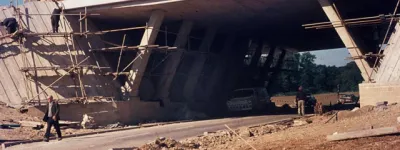As the road-building boom of the early 1960s progressed, hundreds of miles of new motorway came into service, and drivers everywhere had to learn how to use these new facilities. There was no speed limit and many motorists were old enough to have never taken a driving test, so accidents were bound to happen. But the worst accidents, and the greatest casualties and deaths, all happened in the fog. As the pile-ups continued to pile up, the press and public became restless about the dangers of a fog-bound motorway.
The reality was that many accidents and pile-ups were happening due to poor driving — people going too fast in the fog, mainly. There are reports of police cars trying to slow traffic down in thick fog and being repeatedly overtaken by faster traffic. But that did little to combat the feeling that the the authorities were responsible for making the road safe.
With regard to one particularly nasty incident on the M1 on 24 January 1964, which involved 200 vehicles, MPs called for "illuminated signs" to warn motorists of the fog. The Minister, Ernest Marples, began to sound increasingly exasperated as he replied:
"It is no good saying this fog was in belts. It was not in belts. It was forecast, it was expected, it was continuous, it was not patchy, it was widespread, it was not local. You do not need a sign to tell you there is fog when there is fog all around, any more than you need a sign to tell you it is raining when it is pouring with rain. Drivers must adjust speed techniques to prevailing weather conditions. If they are going to operate with folly, then folly will be the answer to them."
Picture credits
- Photograph of Midland Red coach on the M1 by David Jones, from this photo gallery.
- Photograph of the M66 in the fog adapted from an original by David Dixon and used under this Creative Commons licence.
